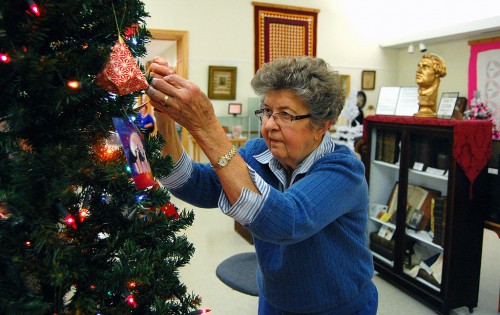 I stopped in at the Lutheran Heritage Center and Museum in Altenburg this Wednesday afternoon to talk with museum director Carla Jordan about a possible project. I noticed folks like Lillian Fiehler buzzing around getting this year’s annual Christmas Display ready for the weekend.
I stopped in at the Lutheran Heritage Center and Museum in Altenburg this Wednesday afternoon to talk with museum director Carla Jordan about a possible project. I noticed folks like Lillian Fiehler buzzing around getting this year’s annual Christmas Display ready for the weekend.
Dressing for Christmas
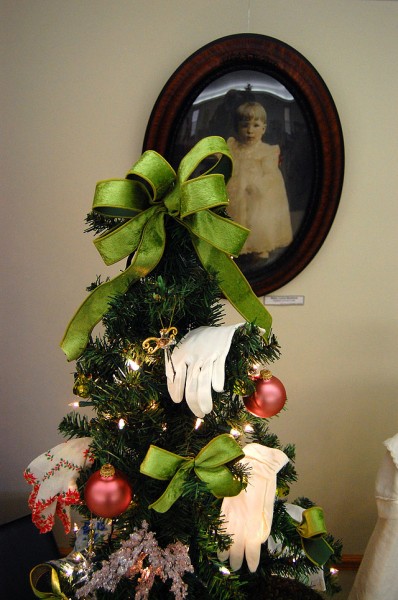 Many of the trees are themed, like this one entitled Dressing for Christmas, which is decorated with gloves and hankies. This is a great place to get decorating ideas that are simple and not expensive.
Many of the trees are themed, like this one entitled Dressing for Christmas, which is decorated with gloves and hankies. This is a great place to get decorating ideas that are simple and not expensive.
Top ornament came from Walmart
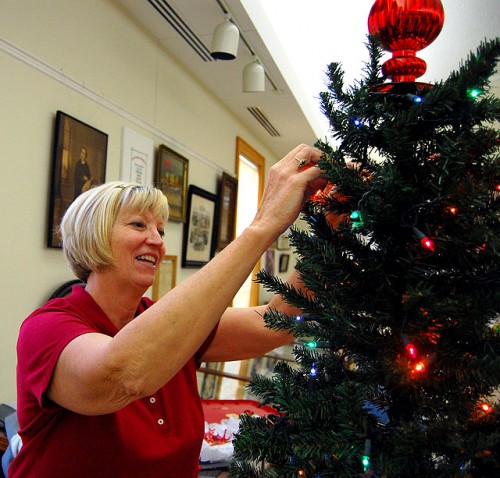 I was admiring the red ornament that topped the tree Carolyn Schmidt was working on. “It came from Walmart,” she confided. They’re not afraid to mix the old and the new if the overall effect works.
I was admiring the red ornament that topped the tree Carolyn Schmidt was working on. “It came from Walmart,” she confided. They’re not afraid to mix the old and the new if the overall effect works.
Scherenschinitte Tree
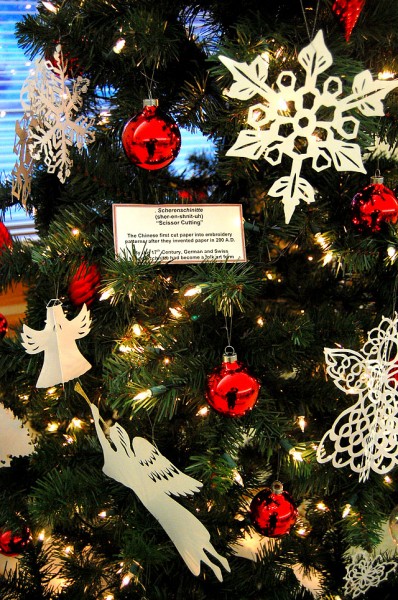 “I’m glad there’s a label on this thing,” I told Carolyn when she introduced me to the Scherenschinitte – Scissor Cutting Tree. “If that wasn’t there to back you up, I’d think you were trying to trick me into running some kind of German cuss word.”
“I’m glad there’s a label on this thing,” I told Carolyn when she introduced me to the Scherenschinitte – Scissor Cutting Tree. “If that wasn’t there to back you up, I’d think you were trying to trick me into running some kind of German cuss word.”
Why the donkey is brown
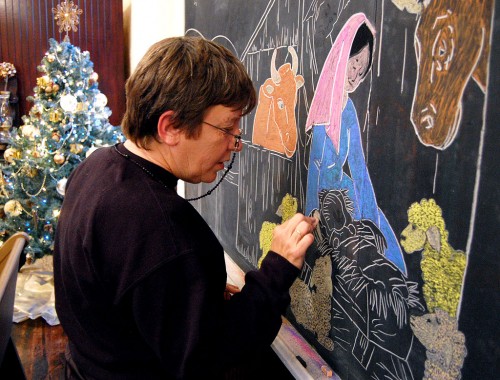 Autumn Hughey was doing a masterful job of coaxing beautiful colors out of chalk to draw a Nativity scene. “In case you were wondering, the donkey is brown because I didn’t have any gray chalk.” To be honest, I hadn’t even noticed, but that’s the answer in case YOU were wondering.
Autumn Hughey was doing a masterful job of coaxing beautiful colors out of chalk to draw a Nativity scene. “In case you were wondering, the donkey is brown because I didn’t have any gray chalk.” To be honest, I hadn’t even noticed, but that’s the answer in case YOU were wondering.
Display up through January 15
Carla said the display should be complete by this weekend. It will be up until January 15. If the first trees are any indication, it’s well worth the drive to Altenburg. To see another example of the quality of their exhibits, read my piece on the Vintage Hats of Perry County from this spring. There’s a map on the page, too.
The Lutheran Heritage Center and Museum’s website has more information.
If you go, tell them I sent you.
German history course
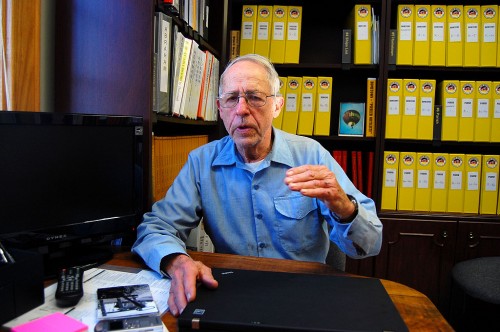 I’ve never been to the museum when I haven’t run into an interesting character. Wilmar Degenhardt, 85, looked at an aerial photo I shot in the 60s and exclaimed, “That’s the farm I grew up on until I was 18-1/2!” For the next hour, he lectured on the early German settlements and German history in general. He crammed in more information than you’d get in a college class. I was afraid he’d hand me a Blue Book and make me write an essay on what he had covered.
I’ve never been to the museum when I haven’t run into an interesting character. Wilmar Degenhardt, 85, looked at an aerial photo I shot in the 60s and exclaimed, “That’s the farm I grew up on until I was 18-1/2!” For the next hour, he lectured on the early German settlements and German history in general. He crammed in more information than you’d get in a college class. I was afraid he’d hand me a Blue Book and make me write an essay on what he had covered.
Photo gallery
Here’s a sneak peek at the early stages of the Christmas display before all of the trees were up. Click on an image to make it larger, then click on the left or right side of the photo to move through the gallery.




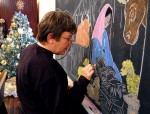

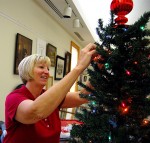
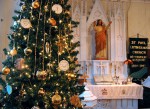





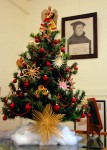




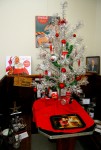
Ken,
Thanks for another wonderful piece. We visited there in October and loved all of the displays. Since my mother grew up in Wittenburg and we often visited relatives in the area, I have special feelings for the sights. Carla is now selling a CD of my son’s Mountain Dulcimer collection of hymns. That was exciting for Carla since Jeff’s great-great grandparents were some of the Saxon emigrants who settled the area.
On the website, Carla mentions your pictures of Wittenburg. I would love to see those.
Thanks for another great piece of work.
Phyllis
I missed seeing the CD. I’ll look for it when I come back in the spring.
I’ll have some Wittenberg photos running before long. One of the reasons I stopped in the museum was to see if anyone could identify some of the people and places I shot in the 60s.
In addition, I’m mulling over a project on the Perry County German settlements. I’ll tell you more if it works out.
We decided to make a quick stop there on our way back from looking at the earthquake last month, but didn’t get to Altenberg before closing time. Moral of the story: Don’t make a tight schedule for yourself when a ferry is involved. We were already cutting the time very close by the time we got to the Dorena-Hickman ferry, and then had to wait while repairs were made to the hydraulics. But we drove there anyway, and there was still enough light to take a few photos outside. The inside will have to wait for another time. The countryside was good to look at, so it was worth the drive. And besides, I prefer to do German heritage in very small doses.
I’ll be interested to hear about your “possible project” if it comes about.
John,
You’ve barely scratched the surface of Missouri.
You won’t find too many states with the rich contrasts the Missouri has as a border state during the Civil War. Geographically, you have the rolling hills that you got a little taste of, that fall off to land so flat they use lasers to grade it.
Wait until you start reading about draining the swamps.
You’ll be back.
Ken, we saw some of that flat country. It looked like after the cotton crops were taken off, they were trying to remove any slightest wrinkle that kept the land from being perfectly flat. But it looked like it was already flatter than any giant flatwork concrete finisher could make it. It may be flatter than the valley of the Red River of the North, which until last month I wouldn’t have thought possible.
But what’s the deal with that cover over the Bible on the altar? Not sure if that’s good symbolism.
I like that photo, though. The altar says “rural German Lutheran church” better than any label you could put on the photo. It wasn’t until my college days that I learned that Lutheran church interiors could be any different than that. As a PK I had been dragged, not altogether willingly, to the inside of a large number of those churches.
Maybe I exaggerate a little bit. Now I miss them.
I wonder who made all those altars. Was it the same mail-order company for everyone, or did different artisans make them according to a common tradition?
Dunno if you saw this blog post of mine about a church in Iowa that had one very like the one in Altenberg: “Disconnecting a Church Building from the Terrain.”
I just now enjoyed re-watching the camera work of the video that I linked there. I suppose it helps if National Geographic can finance aircraft for you to use, and if you can get blue skies upon demand.
John,
Somebody from the museum can answer your question better than I can, but here’s my guess.
The room that the altar is in was once a classroom. It’s been converted into a part of the museum and the altar came from a church that had seen one flood too many in Wittenburg. So, it’s a display piece rather than a an active altar.
The Bible, likewise is probably a historical artifact. For all I know, it might have been one of the infamous “Wicked Bibles,” where there was a typo that dropped the word “not” in front of the commandment dealing with adultery.
I’ll go take a look at your posting. You’re right about National Geographic. They have a special expense account item (no joke) for “gifts to natives.”
I was a big fan of photographer Paul Strand, who did striking portraits and landscapes. I always figured God looked down from his cloud and saw Paul trudging up a hill with his big view camera and would say, “Cue the blast of light, move the cows over to the left, clouds, roll in. He’d let loose a clap of thunder when the scene was perfectly composed to let Paul know when to push the shutter release.”
I think you’ve mentioned Paul Strand before, but this time you made me go and look him up. It looks like he did a lot more than landscapes. His work is good to look at, but I haven’t yet found much of his landscape work on the web. Maybe that’s not the place to find it.
I bought a copy Tir a’Mhurain when I was in college. He and Robert Frank were two of the biggest influences on my early style.
When I got to Ohio, I tried to imitate Jon Webb and Bob Rogers, two shooters on The Athens Messenger. When Jon left for The Louisville Courier-Journal, I was hired as a summer intern, became a full-time staffer and moved up to chief photographer when Bob left.
It was there that I perfected the “environmental portrait” style that is the bedrock of most of my photography. Over the years, I’ve developed the ability to nail a portrait in about 20 minutes.
When you work on small papers, you don’t have a lot of time between assignments.
When I went to work at The Palm Beach Post, I was told that one of my first big assignments would be to illustrate a series on dog racing. They handed me a stack of subjects, a box of film and a map and said, “Good luck.”
I was a little intimidated by how much needed to be shot, but I got it done, spent half the night in the darkroom and handed a stack of prints to my boss the next morning.
“OK, what do you want me to do now?” I asked.
“What do you mean ‘do now?’ You’re blocked off for the week for this assignment.”
I spent the rest of the week plowing the ground I had covered on the first day, but I don’t think I shot anything better than the first take.
Here’s an Amazon link to the book.
Wow, that thing’s worth a lot more than I thought. I guess I should blow the dust off it.
Thanks for sharing, please keep an up-date about this info. appreciate to read it more. i like this site too much. Excellent theme.